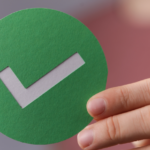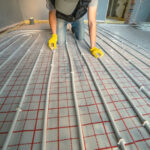Screeds have been an essential part of any construction project, from residential homes to commercial buildings, since the early 19th century. The screed’s job is to cover thermal or acoustic insulation in the floor, to be used with underfloor heating (UFH) to warm the room or simply to level the floor so that it is ready for the final floor covering. This article will explain everything you need to know about screed, from what it is to the different types available. We’ll also look at how it can be applied and why it’s so important.
Screed, also known as thin levelling screed, is a material used to create flat and even surfaces for construction purposes. It is composed of a binder (glue), sand and additives which are combined with water. Traditional screeds use cement as their binder but flowing screeds use cement or anhydrite as theirs.
Screed can be used in three general applications:
- Floating application – the screed is laid onto a compressible layer (insulation board or acoustic matting) to create the final level floor
- Unbonded application – the screed is laid onto the structural subfloor, normally onto a plastic sheet (DPM or slip membrane) to stop the rise of moisture into the final level floor
- Bonded application – the screed is laid onto the structural subfloor by using a glue to stick/bond the screed to the structural subfloor, creating the final level floor
When it comes to using screed effectively, there are three main factors that need to be taken into consideration: the size of the area, the role of the screed and the thickness available. The size of the area is important to which screed is chosen due to cost effectiveness of various screeds, while the role (UFH, heavy loads, thermal insulation acoustic floor, levelling the floor) combined with the thickness available will determine the type / variant of screed best to use.
Pros:
1. Screed is a durable and economical material for flooring.
2. It can be used as a base for other types of flooring such as laminates, tiling, vinyl, carpets or even just paint.
3. Screed can be applied quickly to large surface areas, making it ideal for commercial construction projects with tight timelines.
4. The installation process of screed is easy and requires fewer materials than many other types of flooring options, resulting in cost savings for the contractor and customers alike.
Cons:
1. Screed can be damaged easily by heavy weight, so it is not suitable for locations that require structural load bearing capabilities. Screeds are just a levelling layer.
2. Screeds are solid, therefore their weight needs to be taken into consideration when used on suspended floors.
In conclusion, screeds are an important element in any building project and can add value to a property. It is a versatile material that can be used for both indoor and outdoor applications, making it an ideal choice for those looking to improve their home or commercial premises. Screed comes in a range of types, each offering its own unique benefits, so take the time to discover which type best suits your needs. With the right preparation and materials, you can ensure your screed installation will be a success.





